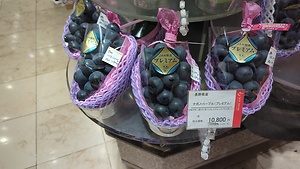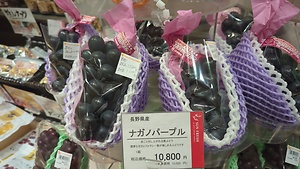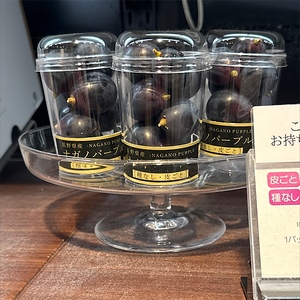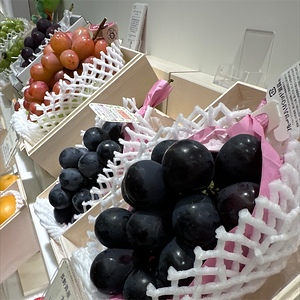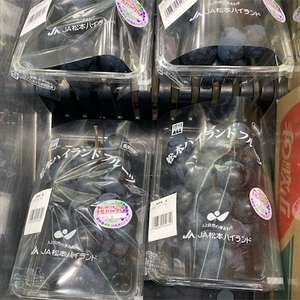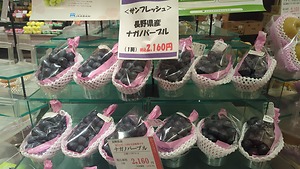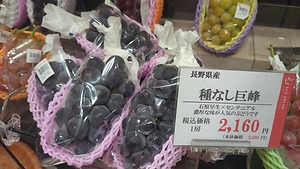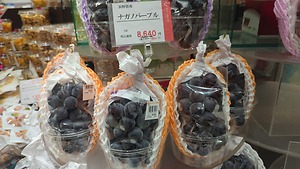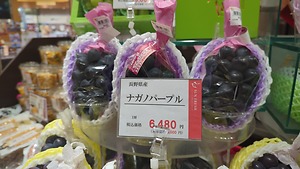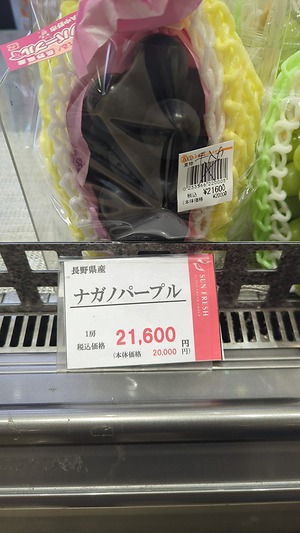

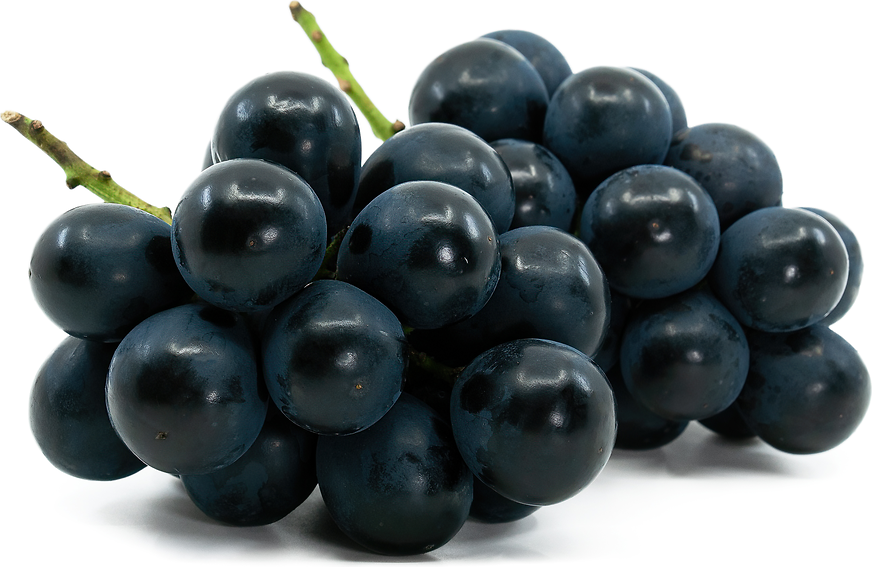
Nagano Grapes
Estimated Inventory, lb : 0
Description/Taste
Nagano grapes are a large varietal growing in small, densely packed bunches on stout vines. Each grape generally reaches between 2 to 4 centimeters in diameter, similar in size to kyoho grapes, and has a plump, oval to oblong appearance, tapering slightly at both ends. The skin is thin and taut with a glossy and smooth consistency. The flesh also bears a dark purple, almost black hue, covered in a pale blue-gray, powdery bloom. This bloom is natural, protecting the grape’s surface from damage and moisture loss, and is edible. It is important to note that the skin will become tougher the more mature it becomes, so consuming the grapes fresh before they over-ripen is recommended. Underneath the surface, the flesh is translucent, seedless, and semi-firm with a crisp but tender, snap-like quality. Nagano grapes emit a notable wine-like aroma and have balanced sugar and acidity, contributing to the grape’s sweet, subtly tangy, true grape flavor.
Seasons/Availability
Nagano grapes are available late summer through fall.
Current Facts
Nagano grapes, botanically classified as Vitis vinifera, are a hybrid variety belonging to the Vitaceae family. The Japanese cultivar was developed in the early 21st century and is a rare variety highly prized for its aroma, flavor, and large size. Nagano grapes were named after the Nagano Prefecture in Japan, the region where the grapes were first developed. The grapes mainly remained localized to the area until 2018, when they were approved for national production. Nagano grapes are favored for their sweet, authentic grape-like flavor and are consumed fresh, out-of-hand as a table grape. Some growers also utilize the grapes for wine, but cultivation for wine production is secondary to growing the bunches for fresh eating. Nagano grapes are sold as a premium fruit in Japanese markets and are carefully wrapped in foam, plastic, and paper packaging.
Nutritional Value
Nagano grapes are an excellent source of vitamin C to strengthen the immune system while reducing inflammation, potassium to balance fluid levels within the body, fiber to regulate the digestive tract, and other nutrients including vitamin K, B vitamins, magnesium, iron, and copper. The grapes also provide plant compounds known as polyphenols that promote healthy circulation and control blood pressure levels. One of the more significant polyphenols found within Nagano grapes is resveratrol which contains antioxidant-like properties to soothe inflammation and protect the cells against damage caused by free radicals.
Applications
Nagano grapes have a wine-like aroma and sweet flavor well suited for fresh preparations. The grapes are most popularly consumed straight, out of hand, and the skins can be left intact or removed, depending on personal preference. Nagano grapes are promoted for their sweet skins, allowing consumers to quickly snack on the fruits without the time-consuming process of peeling each grape. Nagano grapes can also be sliced and mixed into fruit bowls, salads, and harvest bowls, used as a fresh topping over breakfast dishes and ice cream, or served on charcuterie boards as a unique element. In addition to consuming the grapes whole, Nagano grapes can be sliced in half and artfully arranged on tarts, cakes, parfaits, and other desserts. They can also be layered inside of sweet cream-filled sandwiches, frozen and eaten as a fresh sorbet, or simmered into jellies, jams, and other preserves. Beyond raw applications, Nagano grapes can be pressed into juices, fermented into sweet wine, blended into smoothies, or served as a festive cocktail garnish. Nagano grapes pair well with nuts such as almonds, pistachios, and peanuts, fruits including citrus, strawberries, raspberries, and blueberries, herbs such as mint or basil, yogurt, and crème fraiche. Whole, unwashed Nagano grapes will keep up to one week when stored in a container or plastic bag in the refrigerator. The grapes can also be frozen for extended use and generally keep up to one month.
Ethnic/Cultural Info
Nagano grapes are one of the Nagano Prefecture’s most famous varieties and are also known as Nagano Purple grapes. When the large, dark purple grapes are in season, visitors flock to vineyards throughout Nagano to pick their grape bunches. Nagano grapes are traditionally grown on large trellises that create a ceiling-like structure above walkways, causing the grape bunches to hang down for easier access during cultivation. Each grape bunch is meticulously cared for, pruned, and protected by hand-tied bags to prevent sun and insect damage. When visitors arrive at the vineyards, some farms offer all-you-can-eat packages to sample many different varieties, including Nagano, shine muscat, or delaware, or some farms allow guests to take home a small bag of hand-picked bunches. U-pick orchards increase tourism to the agriculturally based regions, and outside of the vineyards, dessert shops offer seasonal sweets utilizing the local Nagano grape. One of the most popular seasonal items is a Nagano grape parfait, layered with grapes sliced in half and arranged in visually stunning tiers. Fruit and cream-filled sandwiches and cakes are also unique items, generally ordered to share with family and friends. In Japan, Nagano grapes are often referred to as “mizugashi,” a descriptor roughly translating to mean “water confectionary.” This term is used to describe fruits that have a pleasantly sweet, juicy, and refreshing taste.
Geography/History
Nagano grapes are native to Japan and were developed at the Nagano Fruit Tree Experiment Station in 2004 in the Nagano prefecture. The variety was created from a cross between kyoho and rosario bianco grapes and was selected for its large size and sweet, juicy flavor. Nagano grapes were initially localized to the Nagano Prefecture, as the region was known for producing quality grapes due to its elevation, arid soil, and temperature fluctuations between day and night. The variety was heavily marketed as a specialty grape, and the cultivar was exported to luxury fruit stores across Japan. In 2018, Nagano grapes were approved for cultivation outside of the Nagano Prefecture in hopes of expanding cultivation to meet increasing demand. Today Nagano grapes are primarily cultivated in Suzaka-shi, Kamitakai-gun, Obuse-machi, and Takayama-mura of the Nagano Prefecture. The grapes are also produced in other areas of Japan and are exported to countries in Southeast Asia, Taiwan, and Hong Kong. Nagano grapes are mainly found through luxury markets, distributors, vineyards, and online retailers.
Recipe Ideas
Recipes that include Nagano Grapes. One
| One Sweet Mess |
|
Ricotta Pound Cake with Grapes |



